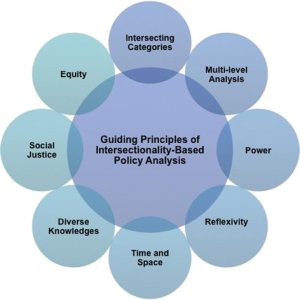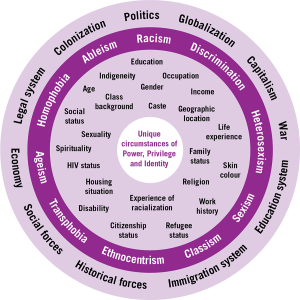Intersectionality in Climate Justice and Disaster Resilience
When climate change intersects with oppressive systems and structures it means that some people face more challenges than others through climate change and before, during, and after disasters.
Using intersectional approaches helps analyse and adress the systems and structures that affect different groups of people who have been and continue to be systematically marginalised. Intersectionality involves understanding how discrimination based on different factors like age, race, sexuality, gender, and disability, as well as conditions like housing, immigration, and marital status, combine to affect people’s experiences and socioeconomic outcomes. Studies in disaster research show the benefits of using intersection approaches to understand how past discrimination and root causes of marginalisation lead to different risks for different communities. Understanding intersecting oppressive systems can highlight how people’s abilities to prepare for, respond to, and recover from disasters vary.
However, these intersectional methods are not used enough in disaster studies and sometimes are not applied deeply. To really make a difference, it is important to move beyond simple views, pay equal attention to different factors, and challenge Western ways of thinking. This will help adress and transform the inequitable experiences and outcomes of climate change and climate disasters.
(Source: Intersectionality as a Forward-Thinking Approach in Disaster Research)
1. What is Intersectionality?
In essence, intersectionality is “a way of thinking about identity and its relationship to power.” – Kimberlé Crenshaw, 2015
What is intersectionality – Video resource (short, under 3 min)
The urgency of intersectionality, TED Talk, Kimberlé Crenshaw – Video resource (18 min)
Intersectionality is a concept and lens that identifies how systems of oppression, like racism, sexism, classism, and ableism, are interconnected and often reinforce each other, functioning in complex and overlapping ways. It emphasises the importance of context in shaping experiences of discrimination and privilege, as the impact of intersecting identities can vary depending on social, cultural, and historical circumstances. Furthermore, intersectionality examines how power operates at different levels, including individual, institutional, and societal, recognising that these power dynamics, though not always visible, significantly influence people’s lives.
The Centre for Intersectional Justice describes intersectionality as follows.
“The concept of intersectionality describes the ways in which systems of inequality based on gender, race, ethnicity, sexual orientation, gender identity, disability, class and other forms of discrimination “intersect” to create unique dynamics and effects. For example, a Muslim woman wearing the Hijab trying to access affordable and climate-safe rentals from a white male real estate agent or homeowner may experience an additional layer of discrimination compared to a white woman or Muslim man. One cannot distinguish if the source of discrimination is her gender or religion, as these two identities are intertwined. The Centre explains that. All forms of inequality are mutually reinforcing and must, therefore, be analysed and addressed simultaneously to prevent one form of inequality from reinforcing another. For example, tackling the gender pay gap alone – without including other dimensions such as race, socio-economic status and immigration status – will likely reinforce inequalities among women.”
(Source: Centre for Intersectional Justice)
2. Intersectionality vs. diversity & inclusion
Frameworks that only consider diversity & inclusion can result in siloed approaches as they only focus on one aspect of diversity in isolation. These isolated initiatives often fail to fully support those with intersecting identities and overlook specific experiences of exclusion.
An intersectional approach to diversity and inclusion is an “and” approach that respects our multiple identities, not an “or” approach that divides them. It requires considering interweaving identities. Even necessary group labels can still compartmentalise and perpetuate discrimination. When we describe people by their differences, even in diversity and inclusion efforts, we often reinforce the norm (male nurse, black senator, gay couple) or reinforce existing power structures (marginalised, disadvantaged). An intersectional perspective pushes us to dissolve the assumptions created by group identities and recognise individuals as unique, multifaceted beings.
Many definitions of intersectionality focus solely on layers of discrimination and disadvantages. However, intersectionality requires understanding the nuanced mix of disadvantages and advantages relative to systemic power dynamics. This perspective leads us to celebrate and value individual differences, ultimately allowing us to see and change those dynamics.
Visit: Person-first language in Climate Justice Toolkit Glossary and Language and Terminologies
Diversity & inclusion vs. intersectionality table
| Diversity & Inclusion | Intersectionality |
| Concerned with the experiences of individuals with diverse attributes | Concerned with the way systems of discrimination and privilege intersect |
| Often results in multiple, siloed approaches to policy development and service provision | Aims for coherent universal design in policy development and service provision |
| Ensures everyone’s ideas have been heard but weights all opinions equally | Centres the voices of people who are systematically marginalised |
| May focus on including marginalised people in existing organisations or programs and assumes existing Western ways of doing and knowing are default. | A way to assess and reflect on power and privilege in relationships, social institutions and structures |
| Assumes that individuals need to be accommodated or assisted to fit into
existing spaces |
An opportunity to advocate for change to structures and systems of inequality |
| May assume existing power relations are natural and view extending access as benevolent. | A way of understanding our own circumstances, experiences and position of power and privilege within society |
| Categorises and measures in ways that may obscure lived experience or result in ranking of discrimination. | Contextual and dynamic, requiring ongoing self-reflection and analysis of power dynamics |
Created by intertwine for the Department of Families, Fairness and Housing. Copyright © State of Victoria, Australia. Reproduced with the permission of the Secretary to the Department of Families, Fairness and Housing. Reproduction and other uses comprised in the copyright are prohibited without permission.
3. Intersectionality principles
A key principle of applying intersectionality within community service organisations (CSOs) is the focus on voices of people at the margins, particularly people who are at the intersections of multiple oppressions. In the context of climate change, these voices are vital, as climate impacts disproportionately affect communities facing systemic barriers. By prioritising diverse knowledges and experiences, CSOs can design climate justice initiatives that address immediate needs while advocating for broader systemic changes.
Incorporating principles of social justice and equity, CSOs must also reflect on their own power dynamics and biases, practising reflexivity in their approaches. By doing so, they can ensure that the needs of those most affected by climate change are central to their efforts, fostering a more equitable future for all.
4. How intersectionality relates to climate justice
Climate justice and intersectionality are deeply interconnected, as the impacts of climate change are not experienced equally across all communities. People who are already marginalised—whether due to sexism, racism, xenophobia, homophobia, transphobia, ableism, or classism—often face disproportionate harm from climate-related events. Evidence suggests that people who experience discrimination and marginalisation may avoid seeking help from police, emergency services and government during climate-related disasters and are also more likely to be left behind. For instance, low-income transgender women of colour may experience compounded discrimination when seeking shelter during a flood disaster, facing barriers related to gender identity, class, and race. Similarly, an older person who is deaf and uses a mobility aid living in a rural area may not receive adequate emergency resources during a bushfire because of the intersections of ageism, ableism, and geography. Intersectionality recognises that these overlapping systems of discrimination can intensify harm, injustice and inequities, making it crucial to approach climate justice through an intersectional lens that considers the unique oppressions faced by people and groups in all their diversities.
The toolkit “Climate Justice Needs an Intersectional Approach” below provides great information about the link between intersectionality and climate justice.
5. Climate justice needs an intersectional approach
The toolkit “Climate Justice Needs an Intersectional Approach” has been developed by Youth and Environment Europe.
The toolkit provides information about the following topics:
Intersectionality and environmental justice
- Exploring how intersectionality and the climate crisis are connected, looking at how power dynamics affect vulnerability and resilience, and understanding why inclusivity is important in environmental decision-making.
Climate impacts on marginalised communities
- Investigating how climate change more severely impacts frontline communities, such as Aboriginal and Torres Strait Islander Peoples, people of colour, low-income groups, and people living in vulnerable areas, and how these effects intersect with other forms of discrimination.
Partnership, representation, and engagement
- Offering advice on creating inclusive discussions, highlighting marginalised voices, and building partnerships to tackle climate challenges together. It also looks at effective strategies for promoting climate justice and bringing intersectional views into policy-making and advocacy.
Tools for intersectional analysis
- Providing users with practical tools, resources, and frameworks to examine how power, privilege, and vulnerability intersect within climate issues. These tools help identify and address inequalities, develop customised solutions, and encourage collaborative approaches to action for climate justice.
6. How to apply intersectional approaches to your climate justice and disaster resilience work
Incorporating an intersectional perspective into climate justice and disaster resilience efforts is crucial for achieving fair and equitable outcomes, particularly within community service organisations. This approach goes beyond theoretical discussions and necessitates actionable strategies that address various systems of oppression, such as racism, sexism, and ableism, which intersect and influence individuals’ experiences with climate change. By recognising these intersections, community service organisations can develop tailored programmes that not only address the specific needs of diverse populations but also promote resilience and well-being in communities most affected by climate impacts.
Consider the actions, points, and questions below to integrate intersectional approaches into your climate justice and disaster resilience work.
Using intersectionality as a tool
In the context of climate justice, intersectionality serves as a practical tool for achieving equitable outcomes. While intersectionality is often presented as a theoretical concept, it is crucial to translate these ideas into actionable strategies. Community service organisations (CSOs) can implement the following practical actions to work towards intersectional climate justice:
- Collaborate: Strengthen collaboration across sectors, communities, and issues to drive transformative processes. CSOs should engage with Aboriginal and Torres Strait Islander Peoples and People with Lived Experience from the communities they serve, as well as collaborate with civil society organisations, local officials, and government representatives who understand the importance of intersectionality. Partnering with local interest groups can uncover opportunities to make services more inclusive.
- Understand realities and gather holistic information: Traditional information collection often fails to capture the experiences of individuals at the intersections of multiple identities, as it typically focuses on isolated aspects. By gathering understanding through yarns and relationships with groups that have been historically overlooked, CSOs can better recognise their unique needs.
- Allocate resources: Conduct context-specific yarns to identify individuals and groups with the least access to rights and resources. In programme or project development, commit to investing in those who are harder to reach to ensure equity in resource allocation.
- Give a platform for voice and visibility: Promote the voices of those most affected by climate issues, enabling communities to advocate for their own goals. It is essential to ensure that individuals from different backgrounds are included and represented in decision-making processes.
- Change internal policy and consider representation: Internal policies within CSOs should protect minority and historically disadvantaged groups, encouraging their full participation in organisational activities.
- Consider cross-issues (cross-disciplines): Reflect on how seemingly unrelated issues intersect, working towards a holistic climate justice approach. Addressing one issue may have unforeseen consequences on another; for example, a community service organisation focused on improving housing conditions may also need to consider how climate change impacts housing stability. Rising temperatures and increased flooding can lead to displacement and housing insecurity, particularly for low-income families. By integrating climate resilience strategies into housing initiatives, such as advocating for energy-efficient building practices and flood-resistant infrastructure, CSOs can better support vulnerable communities while promoting climate justice.
- Advocate: Support the integration of legal clauses in national policies and international agreements that recognise multiple forms of discrimination in the context of climate justice. Community service organisations can advocate for governmental approaches that include socially excluded or hard-to-reach groups, ensuring their voices are heard in climate action discussions. For instance, CSOs can push for policies that provide financial assistance or resources to low-income communities facing the impacts of climate change, such as extreme weather events.
(Adapted from: Integrated Water Resource Management (IWRM) based on guiding principles from a variety of sources, e.g., AWID 2004; Simpson 2009; IGLYO, 2014; The Opportunity Agenda, 2017; Sarwar & Mason 2017; WaterAid, 2018).
Reflecting on intersectionality
The set of questions below can help organisations reflect on their practices, structures, and relationships related to intersectionality. Organisations can use those to better understand and think of how they can strengthen intersectional practice.
Reflective questions (based on IWRM resource) and dimensions of climate justice:
- Distributive Climate Justice: How can we enhance collaboration among various sectors to ensure more inclusive outcomes in our climate-related work, particularly in the fair distribution of resources and benefits?
- Recognitional Climate Justice: What specific disaggregated data can we collect to better understand and address the climate-related needs of communities who are systemically marginalised, ensuring their identities and experiences are recognised?
- Procedural Climate Justice: In what ways can our resource allocation be adjusted to prioritise those who are often overlooked in climate initiatives, ensuring fair and inclusive decision-making processes?
- Restorative Climate Justice: How are we currently amplifying the voices of individuals who experience systemic disadvantage in climate decision-making processes, and what more can we do to address past injustices and restore equity?
- Intergenerational Climate Justice: Are our internal policies actively protecting and promoting the participation of minority groups in actions for climate justice, and how can we assess their effectiveness to ensure future generations are also considered?
- Relational Climate Justice: How can we identify and address the interconnectedness of various social issues and climate justice in our initiatives, fostering strong relationships and mutual support among communities?
- Transformative Climate Justice: What steps can we take to advocate for the inclusion of multiple forms of discrimination in our climate-related frameworks and policies, and how can we deepen, include, and govern for climate justice and disaster resilience effectively?
7. Useful resources
Intersectionality Wheel
The Intersectionality Wheel highlights how diverse systems of power, privilege and oppression intersect and produce multiple and compounded impacts of discrimination and inequities. The wheel visually represents the interconnected nature of various social categories, such as race, gender, class, and ability, illustrating how these intersections can exacerbate experiences of privilege and disadvantage. By recognising these complex relationships, the Intersectionality Wheel serves as a valuable tool for understanding the nuanced ways in which individuals have to navigate societal structures.
(Source: Intersectionality Wheel ADP Health)
Intersectional Climate Justice Conceptual Framework
This figure outlines a conceptual framework that brings together various theories of climate justice, which are important for understanding the implications of climate policies, planning, and actions related to mitigation, adaptation, and loss and damage. The bibliometric review from Parsons et al. (2024) highlights the need for climate justice-centred approaches that incorporate different theories focusing on fairness, equality, and equity concerning impacts, processes, and outcomes. The framework includes five key dimensions of justice: distributive, procedural, recognitional, corrective, and temporal. These dimensions aim to deepen the exploration of climate justice by recognising its complex nature in climate-related situations.
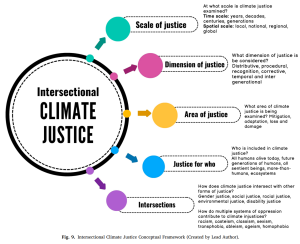
(Source: A bibliometric and topic analysis of climate justice: Mapping trends, voices, and the way forward)
The Privilege Wheel
The Privilege Wheel illustrates the spectrum of attributes individuals possess, showing how these exist on a continuum rather than as binary categories. It highlights that societal structures favour those at one end of the spectrum, leading to privilege for some and disadvantage for others. Individuals can experience both privilege and oppression simultaneously, shaping their unique lived experiences.
The Privilege Wheel emphasises that privileges and oppressions are structural and systemic, embedded in institutions like laws, education, and employment. Therefore, addressing these inequities requires collective action to dismantle systemic barriers, not just individual behaviour. The table below provides accessible labels for understanding these power dynamics.
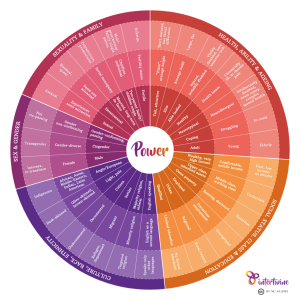
For an accessible version of this wheel, see Privilege, Resistance and Proximity to Power. Also, see intertwine’s glossary of terms designed to accompany the wheel.
8. Intersectionality team training
The following training programs are available to Western Australian community service organisation staff individually or as a group. At present, none of these trainings are specific to climate justice and disaster resilience, but this Toolkit includes resources and workshop tools that connect intersectionality and climate justice.
intertwine – transforming communities together
intertwine provides introductory and advanced intersectionality training sessions for people at all organisational levels. Their training supports people in moving beyond diversity and sensitivity training towards understanding justice and equity.
intertwine Intersectionality Training
United Nations High Commissioner for Refugees
UNHCR has developed three online training modules that can be used as a tool within Community Service Organisations to help them learn and integrate intersectionality into their programs and practice.
Training materials and resources (UNHCR)
Module 1 – What are ‘intersectionality’ and the ‘Age, Gender and Diversity’ approach?
Module 2 – ‘Intersectionality’ and ‘Age, Gender and Diversity’: Why do they matter?
Module 3 – ‘Intersectionality’ and ‘Age, Gender and Diversity’: How can we use them?
Intersectionality training series
Intersectionality Training Series (Multicultural Centre for Women’s Health)
Centering intersectionality, equity and justice – training
Intersectionality Training (Ananda Training & Consultancy — Centring Intersectionality, Equity and Justice)
9. Read more
Explaining intersectionality (Time)
What is intersectionality, and why is it important (AAUP)
Climate Justice Needs an Intersectional Approach toolkit recommends several additional resources to better understand intersectionality (see last pages of the toolkit).
We aren’t all equal when it comes to climate vulnerability
